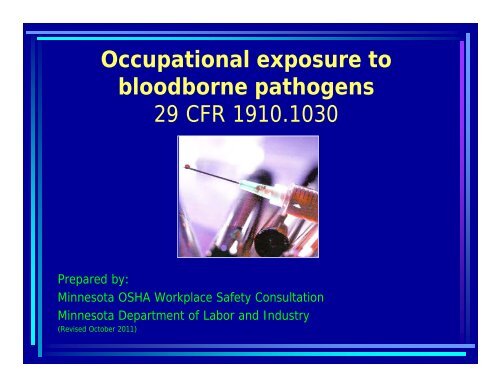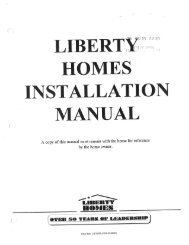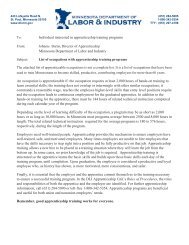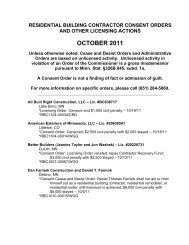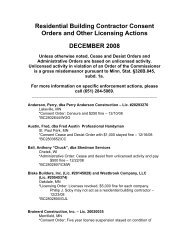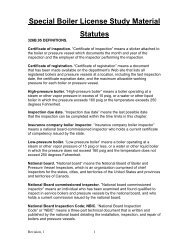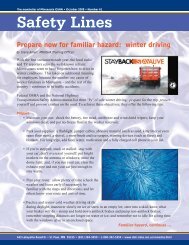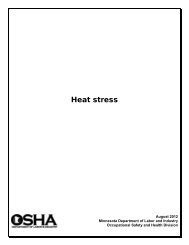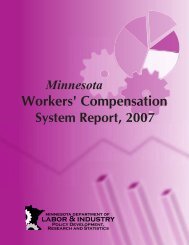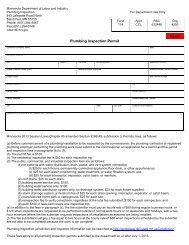Bloodborne pathogens - Minnesota Department of Labor and Industry
Bloodborne pathogens - Minnesota Department of Labor and Industry
Bloodborne pathogens - Minnesota Department of Labor and Industry
Create successful ePaper yourself
Turn your PDF publications into a flip-book with our unique Google optimized e-Paper software.
Why is a st<strong>and</strong>ard needed? OSHA estimates eight million workers in the health care industry<strong>and</strong> related occupations are at risk <strong>of</strong> occupational exposure tobloodborne <strong>pathogens</strong>, including Human Immunodeficiency Virus(HIV, the virus that causes AIDS), hepatitis B virus (HBV) <strong>and</strong>hepatitisC cirus(HCV). According to the Centers for Disease Control <strong>and</strong> Prevention(CDC), 100,000 Americans have died from AIDS <strong>and</strong> more than onemillion Americans are infected with HIV. About 65 cases <strong>of</strong> HIV infection due to occupational exposureoccur each year.
Why is a st<strong>and</strong>ard needed? About 8,700 health care workers are infected with hepatitis Beach year. About 200 health care workers die from hepatitis B each year. One milliliter <strong>of</strong> blood can contain more than one millioninfectious doses <strong>of</strong> the hepatitis B virus. Sixty to 70 percent <strong>of</strong> the individuals infected with the hepatitisC virus show no discernable symptoms. According to the CDC, hepatitis C virus infection is the mostcommon chronic bloodborne infection in the United States.
OSHA’s bloodborne <strong>pathogens</strong> st<strong>and</strong>ard(29 CFR 1910.1030) prescribessafeguards to protect workers against thehealth hazards from exposure to blood<strong>and</strong> other potentially infectious materials,<strong>and</strong> to reduce their risk from thisexposure.– The original st<strong>and</strong>ard became effective in<strong>Minnesota</strong> on June 6, 1992.
Who is covered by the st<strong>and</strong>ard? All employees who could be “reasonablyanticipated” as the result <strong>of</strong> performing theirassigned job duties to face contact withblood or other potentially infectious materialsare covered by the st<strong>and</strong>ard. “Good samaritan” acts, such as assisting acoworker with a nosebleed, would not beconsidered occupational exposure.
Some workers who are at risk Physicians Nurses Emergency room personnel Orderlies Housekeeping personnel Laundry workers <strong>Labor</strong>atory personnel Blood bank personnel Medical examiners Dentists <strong>and</strong> dental workers Morticians Law enforcement personnel Firefighters Paramedics Emergency medical technicians Medical waste h<strong>and</strong>lers Home health care workers Employees assigned to first-aidresponse duties by theiremployer Other workers assigned dutiesputting them at risk <strong>of</strong>occupational exposure
How does exposure occur? Needlesticks (most common)– 800,000 needlestick injuries occur each year in the U.S. Cuts from other contaminated sharps(scalpels, broken glass, etc.) Contaminated blood contact with theeyes, mucous membranes <strong>of</strong> the mouthor nose, or broken (cut or abraded) skin
Because <strong>of</strong> the large number <strong>of</strong>occupational needlestick injuries toemployees, many <strong>of</strong> which are notreported, the Needlestick Safety <strong>and</strong>Prevention Act was passed in 2000.The Needlestick Safety <strong>and</strong>Prevention Act m<strong>and</strong>atedOSHA to clarify <strong>and</strong> revise29 CFR 1910.1030,<strong>Bloodborne</strong> Pathogens.
Needlestick Safety <strong>and</strong> Prevention Acttimeline Public Law 106-430 was signed Nov. 6, 2000. The revised OSHA bloodborne <strong>pathogens</strong> st<strong>and</strong>ardincorporating these changes was published in theFederal Register Jan. 18, 2001*. The effective date for OSHA changes was April 18,2001. <strong>Minnesota</strong> OSHA adopted the revised bloodborne<strong>pathogens</strong> st<strong>and</strong>ard on Oct. 1, 2001.*These changes will be noted throughout this presentation.
Format <strong>of</strong> 29 CFR 1910.1030(a) Scope <strong>and</strong> application(b) Definitions*(c) Exposure control(1) Exposure control plan*(2) Exposure determination(d) Methods <strong>of</strong> compliance(1) General (universal precautions)(2) Engineering* <strong>and</strong> work practicecontrols(3) Personal protective equipment(4) Housekeeping(e) HIV <strong>and</strong> HBV research laboratories <strong>and</strong>production facilities(f) Hepatitis B vaccination <strong>and</strong> postexposureevaluation <strong>and</strong> follow-up(1) General(2) Hepatitis B vaccination(3) Post-exposure evaluation <strong>and</strong>follow-up(f)(4) Information provided to thehealth care pr<strong>of</strong>essional(5) Health care pr<strong>of</strong>essional’swritten opinion(g) Communication <strong>of</strong> hazards toemployees(1) Labels <strong>and</strong> signs(2) Information <strong>and</strong> training(h) Recordkeeping(1) Medical records(2) Training records(3) Availability(4) Transfer <strong>of</strong> records(5) Sharps injury log*(i) Dates*Denotes changes to the st<strong>and</strong>ardpublished in the Jan. 18, 2001,edition <strong>of</strong> the Federal Register.
Scope <strong>and</strong> application:Paragraph (a)‣ The st<strong>and</strong>ard applies to all employees in general industrywith occupational exposures to blood <strong>and</strong> other potentiallyinfectious materials.‣ Construction, maritime <strong>and</strong> agriculture workplaces arenot covered by this st<strong>and</strong>ard; however, the <strong>Minnesota</strong>Employee Right-to-Know st<strong>and</strong>ard’s requirements regardinginfectious agents would apply in those workplaces (see<strong>Minnesota</strong> Rules Chapter 5206).
Scope <strong>and</strong> application:Paragraph (a)‣ Part-time workers, temporary workers <strong>and</strong> workersknown as “per diem” employees per the above criteriawould be covered. Students <strong>and</strong> volunteers (if theyreceive any type <strong>of</strong> compensation) per the above criteriawould also be covered.‣ Employees in general industry who are trained in firstaid <strong>and</strong> designated by their employer as responsible forrendering medical assistance as part <strong>of</strong> their job dutieswould be covered.
• Assistant secretary• Blood• <strong>Bloodborne</strong> <strong>pathogens</strong>• Clinical laboratory• Contaminated• Contaminated laundry• Contaminated sharps• Decontamination• Director• Engineering controls*• Exposure incident• H<strong>and</strong>washing facilities• Licensed health care pr<strong>of</strong>essional• HBV• HIV• Needleless systems*Definitions:Paragraph (b)• Occupational exposure• Other potentially infectious materials• Parenteral• Personal protective equipment• Production facility• Regulated waste• Research laboratory• Sharps with engineered sharps injuryprotections (SESIPs)*• Source individual• Sterilize• Universal precautions• Work practice controls*Denotes a change to the bloodborne<strong>pathogens</strong> st<strong>and</strong>ard as published in theJan. 18, 2001, edition <strong>of</strong> the Federal Register.
Definitions:Paragraph (b)• Paragraph (b) <strong>of</strong> the st<strong>and</strong>ard defines the terms usedthroughout the document.• When reviewing <strong>and</strong> interpreting the st<strong>and</strong>ard forimplementation, underst<strong>and</strong>ing the exact meaning <strong>of</strong> theseterms is critical.• In most cases, the definitions are self-explanatory <strong>and</strong>will not be covered in this program; however, the followingare some definitions that require further clarification or arethe definitions that pertain to the changes set forth in theJan. 18, 2001, edition <strong>of</strong> the Federal Register.
Definitions:Paragraph (b)• “Blood” means human blood, human bloodcomponents <strong>and</strong> products made from human blood.• Human blood components include plasma, platelets<strong>and</strong> serosanguineous fluids (e.g. exudates fromwounds).• Also included are medications derived from blood,such as immune globulins, albumin <strong>and</strong> factors 8 <strong>and</strong> 9.
Definitions:Paragraph (b)“<strong>Bloodborne</strong> <strong>pathogens</strong>” means pathogenicmicroorganisms that are present in human blood <strong>and</strong>can cause disease in humans. These <strong>pathogens</strong>include, the hepatitis B virus <strong>and</strong> the humanimmunodeficiency virus (HIV).• While HBV <strong>and</strong> HIV are specifically identified in thest<strong>and</strong>ard, the term includes any pathogenic microorganismthat is present in human blood <strong>and</strong> can infect<strong>and</strong> cause disease in people who are exposed to bloodcontaining the pathogen.
Definitions:Paragraph (b)• “Contaminated” means the presence or the reasonablyanticipated presence <strong>of</strong> blood or other potentiallyinfectious materials on an item or surface.• “Contaminated sharps” means any contaminatedobject that can penetrate the skin, including needles,scalpels, broken glass, broken capillary tubes <strong>and</strong>exposed ends <strong>of</strong> dental wires.
Definitions:Paragraph (b)“Decontamination” means the use <strong>of</strong> physical orchemical means to remove, inactivate or destroybloodborne <strong>pathogens</strong> on a surface or item to the pointwhere they are no longer capable <strong>of</strong> transmittinginfectious particles <strong>and</strong> the surface or item is renderedsafe for h<strong>and</strong>ling, use or disposal.
Definitions:Paragraph (b)• “Exposure incident” means a specific eye, mouth, othermucous membrane, non-intact skin or parenteral contactwith blood or other potentially infectious materials thatresults from the performance <strong>of</strong> an employee’s duties.• Non-intact skin includes skin with dermatitis, hang-nails,cuts, abrasions, chafing, acne, etc.• Parenteral means piercing mucous membranes or theskin barrier though such events as needle sticks, humanbites, cuts <strong>and</strong> abrasions.• When an employee experiences an “exposure incident,”the employer must institute the required follow-upprocedures in their plan.
Definitions:Paragraph (b)• “Occupational exposure” means reasonably anticipated skin, eye, mucousmembrane or parenteral contact with blood that may result from theperformance <strong>of</strong> an employee’s duties.• Reasonably anticipated exposure includes the potential for exposure, aswell as actual exposure to blood or other potentially infectious materials(OPIM). It includes exposure to blood or OPIM (including regulated waste),as well as incidents <strong>of</strong> needlesticks.• A determination that an employee has “occupational exposure” basedupon job assignment triggers the requirement that the employer provide,<strong>and</strong> include the affected employee in, the employer’s exposure control plan.• Employees assigned first-aid response duties by their employer would beconsidered to have “occupational exposure.”• This definition does not cover “good samaritan” acts (i.e. voluntarily aidingsomeone in one’s place <strong>of</strong> employment) that result in exposure to blood orOPIM.
Definitions:Paragraph (b)“Other potentially infectious materials” means:1) human body fluids, including semen, vaginal secretions, cerebrospinalfluid, synovial fluid, pleural fluid, pericardial fluid, peritoneal fluid,amniotic fluid, saliva in dental procedures, any body fluid visiblycontaminated with blood <strong>and</strong> all body fluids in situations where it isdifficult or impossible to differentiate between body fluids;2) any unfixed tissue or organ (other than intact skin) from a human(living or dead); <strong>and</strong>3) HIV-containing cell or tissue cultures, organ cultures <strong>and</strong> HIV- or HBVcontainingculture medium or other solutions, as well as blood, organsor other tissues from experimental animals infected with HIV or HBV.• Urine <strong>and</strong> feces are not OPIM unless they are visibly contaminatedwith blood.
Definitions:Paragraph (b)• “Regulated waste” means liquid or semi-liquid blood or OPIM;contaminated items that would release blood or OPIM in a liquid orsemi-liquid state if compressed; items that are caked with dried bloodor OPIM <strong>and</strong> are capable <strong>of</strong> releasing these materials during h<strong>and</strong>ling;contaminated sharps; <strong>and</strong> pathological <strong>and</strong> microbiological wastescontaining blood or OPIM.• While in a facility, regulated waste must be h<strong>and</strong>led <strong>and</strong> labeled per therequirements in the OSHA bloodborne <strong>pathogens</strong> st<strong>and</strong>ard.• In <strong>Minnesota</strong>, a non-OSHA regulation, the Infectious Waste Control Act(<strong>Minnesota</strong> Statutes 116.78 through 116.82), addresses the required labeling<strong>of</strong> infectious waste after it leaves a facility, <strong>and</strong> the required transport <strong>and</strong>disposal <strong>of</strong> infectious waste by licensed personnel. This regulation is underthe jurisdiction <strong>of</strong> the <strong>Minnesota</strong> Pollution Control Agency. For moreinformation about the Infectious Waste Control Act, call (507) 344-5243.
Definitions:Paragraph (b)• “Engineering controls*” means controls (e.g., sharpsdisposal containers, self-sheathing needles <strong>and</strong> safermedical devices, such as sharps with engineeredsharps injury protections <strong>and</strong> needleless systems) thatisolate or remove the bloodborne <strong>pathogens</strong> hazardfrom the workplace.• Includes SESIPs <strong>and</strong> needleless systems*Denotes a change to the bloodborne <strong>pathogens</strong> st<strong>and</strong>ard as published inthe Jan. 18, 2001, edition <strong>of</strong> the Federal Register.
Definitions:Paragraph (b)• ”Needleless systems*” means a device that does not use needles for:1) the collection <strong>of</strong> bodily fluids or withdrawal <strong>of</strong> body fluids after initialvenous or arterial access is established;2) the administration <strong>of</strong> medication or fluids; or3) any other procedure involving the potential for occupationalexposure to bloodborne <strong>pathogens</strong> due to percutaneous injuries fromcontaminated sharps.• Examples:– intraveneous medication delivery systems that administer medicationsor fluids through a catheter port or connector site using a bluntcannuala or other non-needle connection; <strong>and</strong>– jet injection systems that deliver subcutaneaous or intramuscularinjections <strong>of</strong> liquid medications through the skin without use <strong>of</strong> aneedle.*Denotes a change to the bloodborne <strong>pathogens</strong> st<strong>and</strong>ard as published in theJan. 18, 2001, edition <strong>of</strong> the Federal Register.
Definitions:Paragraph (b)• “Sharps with engineered sharps injury protections*” means a non-needlesharp or needle device used for withdrawing body fluids, accessing a vein orartery, or administering medications or other fluids with a built-in safetyfeature or mechanism that effectively reduces the risk <strong>of</strong> an exposureincident.• Commonly referred to as SESIPs.• Examples: syringes with guards or sliding sheaths; retractable needlesyringes; shielded or retracting catheters; delivery systems using catheterports or connector sites using a needle that is housed in a protectivecovering; blunt suture needles; <strong>and</strong> plastic (not glass) capillary tubes.*Denotes a change to the bloodborne <strong>pathogens</strong> st<strong>and</strong>ard as published inthe Jan. 18, 2001, edition <strong>of</strong> the Federal Register.
Engineering controls:hypodermic syringes that contain the hazardSyringe with retractable needleAfter the needle is used, an extra push on the plungerretracts the needle into the syringe, removing the hazard<strong>of</strong> needle exposure.*Note: This safety device does not reset in actual use situations. The animation resets for viewerconvenience only.
Engineering controls:hypodermic syringes that contain the hazardSelf re-sheathing needlesInitially, the sleeve is located over the barrel <strong>of</strong> the syringe with theneedle exposed for use. After the device is used, the user slides thesleeve forward over the needle, where it locks in place <strong>and</strong> provides aguard around the used needle. Some designs have a shield that must betwisted to engage the lock. This type <strong>of</strong> device is also available onphlebotomy blood tube holders.*Note: This safety device does not reset in actual use situations. The animation resets forviewer convenience only.
Engineering controls:hypodermic syringes that contain the hazard"Add-on" safety featureHinged or sliding shields attached to syringes, phlebotomy needles,winged steel needles <strong>and</strong> blood gas needles.
Engineering controls:blood tube holders that contain the hazardBlunting needleAfter use, a blunt internal cannula is activated that moves the blunt tipneedle forward through the hollow needle <strong>and</strong> past the sharp needlepoint. The blunt point tip <strong>of</strong> this needle can be activated before it isremoved from the vein or artery. This type <strong>of</strong> device is available onhypodermic syringes <strong>and</strong> phlebotomy blood tube holders.*Note: This safety device does not reset in actual use situations. The animation resets forviewer convenience only.
Engineering controls:scalpels that contain the hazardRe-sheathing disposable scalpelsSingle-use disposable scalpels have a shield that is advancedforward over the blade after use, containing <strong>and</strong> removing thehazard.
Engineering controls:lancets that contain the hazardRetracting finger/heallancetThis single-use lancetautomatically retracts after use,containing <strong>and</strong> removing thehazard.*Note: This safety device does not reset inactual use situations. The animation resets forviewer convenience only.
Engineering controls:vascular access device that contains the hazardBlunting winged steel needlesAfter placement, the third wing is rotated to a flat position that bluntsthe needle point before it is removed from the patient.
Engineering controls:I.V. devices that contain the hazardNeedleless I.V. connectorThe FDA urges using needleless systems or recessed needle systems toreduce the risk <strong>of</strong> needlestick injuries. These connectors use devices otherthan needles to connect one I.V. to another. This example shows theplunger-type system.
Exposure control:Paragraph (c)‣ Paragraph (c) <strong>of</strong> the st<strong>and</strong>ard discussesexposure control.‣ Employees incur risk each time they areexposed to bloodborne <strong>pathogens</strong>. Anyexposure incident may result in infection <strong>and</strong>subsequent illness. Because it is possible tobecome infected from a single exposureincident, exposure incidents must be preventedwhenever possible.
Exposure control plan:Paragraph (c)(1)‣ To eliminate or minimize employee exposure to blood<strong>and</strong> OPIM, the employer is required to develop a writtenexposure control plan.The exposure control plan is akey provision <strong>of</strong> the st<strong>and</strong>ard.It requires the employer toidentify employees who willreceive the training, protectiveequipment, vaccination <strong>and</strong>other provisions <strong>of</strong> thest<strong>and</strong>ard.
Exposure control plan:Paragraph (c)(1)The exposure control plan shall contain:‣ the exposure determination as required in paragraph (c)(2);‣ the schedule <strong>and</strong> method <strong>of</strong> implementing paragraphs (d) Methods<strong>of</strong> compliance, (e) HIV <strong>and</strong> HBV research laboratories <strong>and</strong> productionfacilities, (f) Hepatitis B vaccination <strong>and</strong> follow-up, (g) Communication<strong>of</strong> hazards to employees <strong>and</strong> (h) recordkeeping <strong>of</strong> the st<strong>and</strong>ard; <strong>and</strong>‣ the procedures for evaluating circumstances surrounding exposureincidents as required by paragraph (f)(3)(i) <strong>of</strong> the st<strong>and</strong>ard.
Exposure control plan:Paragraph (c)(1)‣ Each employer shall ensure a copy <strong>of</strong> the exposurecontrol plan is accessible to employees.‣The exposure control plan shall be made available to<strong>Minnesota</strong> OSHA Enforcement inspectors upon requestfor examination <strong>and</strong> copying.
Exposure control plan:Paragraph (c)(1)(iv)*The exposure control plan shall be reviewed <strong>and</strong> updated at leastannually <strong>and</strong> whenever necessary to reflect new or modifiedtasks <strong>and</strong> procedures that affect occupational exposure <strong>and</strong> toreflect new or revised employee positions with occupationalexposure. The review <strong>and</strong> update <strong>of</strong> such plans shall also:(A) reflect changes in technology to eliminate or reduce exposureto bloodborne <strong>pathogens</strong>; <strong>and</strong>(B) document, annually, consideration <strong>and</strong> implementation <strong>of</strong>appropriately commercially available <strong>and</strong> effective safermedical devices designed to eliminate or minimizeoccupational exposure.*Denotes a change to the bloodborne <strong>pathogens</strong> st<strong>and</strong>ard as published inthe Jan. 18, 2001, edition <strong>of</strong> the Federal Register.
Exposure control plan:Paragraph (c)(1)(v)*An employer that is required to establish an exposurecontrol plan shall solicit input from nonmanagerialemployees responsible for direct patient care who arepotentially exposed to injuries from contaminatedsharps in the identification, evaluation <strong>and</strong> selection <strong>of</strong>effective engineering <strong>and</strong> work practice controls, <strong>and</strong>shall document the solicitation in the exposure controlplan.*Denotes a change to the bloodborne <strong>pathogens</strong> st<strong>and</strong>ard as published inthe Jan. 18, 2001, edition <strong>of</strong> the Federal Register.
Exposure control plan:Paragraph (c)(1)(v)• Methods for soliciting employee input in engineering<strong>and</strong> work practice control evaluations may includeemployee involvement in:– joint labor-management safety committees (which are requiredin <strong>Minnesota</strong> workplaces with 25 or more employees);– problem-solving groups;– safety meetings <strong>and</strong> audits;– employee surveys;– worksite inspections;– exposure incident investigations;– written employee comments; <strong>and</strong>– pilot testing programs.
Exposure control plan:Paragraph (c)(1)(v)• An employer with multiple worksites may opt for the followingapproach, instead <strong>of</strong> individual site-separate engineering <strong>and</strong> workpractice control evaluations.(A) Conduct initial product evaluations at the corporate level by ateam that includes nonmanagerial employees involved in the carepractices that will be affected by the devices being evaluated.(B) The devices recommended by the corporate level evaluationteam can then be sent to other sites for implementation.(C) The employer should establish a procedure for employees at thesmaller worksites to report problems with a new device or to suggesta new device for evaluation.
<strong>Minnesota</strong> Statutes 182.6555• “Reducing occupational exposures to bloodborne <strong>pathogens</strong> throughsharps injuries”• The law was signed by the governor April 10, 2000 <strong>and</strong> became effectiveJune 10, 2000. (It preceded the federal bloodborne <strong>pathogens</strong> st<strong>and</strong>ardchanges.)• It requires that employees be involved in the selection <strong>of</strong> effectiveengineering controls to improve employee acceptance <strong>of</strong> the newer devices<strong>and</strong> to improve the quality <strong>of</strong> the selection process.• Where a safety committee is established, it requires the safety committeeto provide advisory recommendations for the use <strong>of</strong> effective engineeringcontrols. At least one-half <strong>of</strong> the members <strong>of</strong> the safety committee (orsubcommittee) must be employee representatives <strong>of</strong> the job classificationsthat would use any device in the category being evaluated.• The law requires annual review <strong>and</strong> documentation <strong>of</strong> information in afacility’s bloodborne <strong>pathogens</strong> exposure control plan.
Exposure determination:Paragraph (c)(2)• A key element <strong>of</strong> the exposure control plan isthe exposure determination.• In the exposure determination, the employeris required to identify <strong>and</strong> document jobclassifications where occupational exposure toblood <strong>and</strong> OPIM can occur. This determinationshall be made without regard to using personalprotective equipment.
Exposure determination:Paragraph (c)(2)• Depending on the results <strong>of</strong> the employer’s occupational exposureassessment, the employer’s written exposure determination maycontain one or two lists.– List 1 will identify job classifications in which all employees inthose job classification have occupational exposure.– List 2, if applicable, will identify job classifications in whichsome employees in those job classifications have occupationalexposure. For List 2, the tasks <strong>and</strong> procedures or groups <strong>of</strong>closely related tasks <strong>and</strong> procedures in which occupationalexposure occurs must be indicated.
Methods <strong>of</strong> compliance:Paragraph (d)Paragraph (d) <strong>of</strong> the st<strong>and</strong>ard sets forth the methodsby which employers shall protect their employeesfrom the hazards <strong>of</strong> bloodborne <strong>pathogens</strong> <strong>and</strong>comply with this st<strong>and</strong>ard through the use <strong>of</strong>universal precautions, engineering <strong>and</strong> workpractices controls, personal protective equipment,proper housekeeping <strong>and</strong> the h<strong>and</strong>ling <strong>of</strong> regulatedwaste.
Univeral precautions:Paragraph (d)(1) Universal precautions shall be observed to prevent contactwith blood or OPIM. Under circumstances in whichdifferentiation between body fluid types is difficult orimpossible, all body fluids shall be considered potentiallyinfectious materials.• “Universal precautions” is an approach to infection control. According to the concept,all human blood <strong>and</strong> certain human body fluids are treated as if known to be infectiousfor HIV, HBV <strong>and</strong> other bloodborne <strong>pathogens</strong>.• Assume the above status regardless <strong>of</strong> the perceived “low risk” status <strong>of</strong> a patient orpatient population.• As alternative concepts <strong>of</strong> infection control, body substance isolation (BSI) or st<strong>and</strong>ardprecautions are also acceptable because these methods exp<strong>and</strong> coverage to include allbody fluids <strong>and</strong> substances, <strong>and</strong> to treat them as if known to be infectious.
Engineering <strong>and</strong> work practice controls:Paragraph (d)(2)Engineering <strong>and</strong> work practice controls shall be used toeliminate or minimize employee exposure.‣ These are the primary methods used to control the transmission<strong>of</strong> bloodborne <strong>pathogens</strong>.‣ Engineering <strong>and</strong> work practice controls shall be used inpreference to other methods as a good industrial hygiene practice<strong>and</strong> in adherence to OSHA’s traditional hierarchy <strong>of</strong> controls.‣ When occupational exposure remains after engineering <strong>and</strong> workpractice controls are put in place, personal protective equipmentmust be used.
Engineering controlsThese controls reduceemployee exposure by eitherremoving the hazard orisolating the worker.
Engineering control examples‣ Sharps disposalcontainers must beprovided <strong>and</strong> used.‣ Sharps disposalcontainers must beleakpro<strong>of</strong>, punctureresistant, able to beclosed, <strong>and</strong> labeledor color-coded.
Engineering control examplesSafe medical devices, including SESIPs<strong>and</strong> needleless systems, should beevaluated (with employee-user input),selected <strong>and</strong> their use implemented.
Engineering control examples‣ Employers shall provideh<strong>and</strong>washing facilities thatare readily accessible toemployees.‣ When provision <strong>of</strong>h<strong>and</strong>washing facilitiesis not feasible, theemployer shall provideeither an appropriateantiseptic h<strong>and</strong> cleanser inconjunction with cleancloth/paper towels orantiseptic towelettes.
Engineering control examples‣ Mouthpieces <strong>and</strong>resuscitation devicesmust be suppliedwhere employeesare expected toperform CPR as anassigned duty.
Work practice controlsThese controls reduce thelikelihood <strong>of</strong> exposure byaltering how a task isperformed.
Work practice controls‣ Wash h<strong>and</strong>s after removinggloves <strong>and</strong> as soon as possibleafter exposure occurs.‣ After use, place disposablecontaminated sharps in animmediately accessible sharpscontainer (SESIPs, with thesafety device activated, muststill be placed in a sharpscontainer).
Work practice controls‣ Prohibit the bending,recapping or removal <strong>of</strong>contaminated needles,unless the action is requiredby a specific medicalprocedure, <strong>and</strong> then onlythrough the use <strong>of</strong> amechanical device or oneh<strong>and</strong>edtechnique.Document when <strong>and</strong> whereit is allowed, in theexposure control plan.‣ Shearing or breakingcontaminated needles isprohibited.
Work practice controls‣ Immediately or as soonas possible after use,contaminated reusablesharps shall be placed inpuncture-resistant,leakpro<strong>of</strong>, <strong>and</strong> labeled orcolor-coded containersuntil properlyreprocessed. (To avoidspillage <strong>of</strong> contents, it issuggested they becovered <strong>and</strong> securedprior to moving.)
Work practice controls‣ Eating, drinking,smoking, applyingcosmetics or lip balm<strong>and</strong> h<strong>and</strong>ling contactlenses are prohibitedin work areas wherethere is a reasonablelikelihood <strong>of</strong>occupationalexposure.
Work practice controlsFood <strong>and</strong> drink shallnot be kept inrefrigerators, infreezers, on shelves,in cabinets or oncountertops orbenchtops whereblood or OPIM arepresent.
Work practice controls‣ All proceduresinvolving blood orOPIM shall beperformed in such amanner as tominimize splashing,spraying, spattering<strong>and</strong> generation <strong>of</strong>droplets <strong>of</strong> thesesubstances.
Work practice controls‣ Mouthpipetting/suctioning<strong>of</strong> blood or OPIM isprohibited. Usemechanical devices.
Work practice controls‣ Specimens <strong>of</strong> blood or OPIMshall be placed in a containerthat prevents leakage duringcollection h<strong>and</strong>ling, processing,storage, transport or shipping(a secondary container isneeded if outside <strong>of</strong> primarycontainer is contaminated or ifit could be punctured by thespecimen).‣ Equipment to be serviced orshipped must bedecontaminated or markedwith a readily observable label.
Personal protective equipment:Paragraph (d)(3) Personal protective equipment (PPE) must beprovided to <strong>and</strong> used by workers if occupationalexposure remains after instituting engineering <strong>and</strong>work practice controls, or if those controls are notfeasible. Personal protective equipment is specialized clothingor equipment that is worn by an employee forprotection against infectious agents. Where required, PPE must be provided at no cost tothe employee. Appropriate sizes must be accessible.
Personal protective equipment:Paragraph (d)(3) PPE must be removed prior to leaving a work area orupon contamination. PPE must be properly cleaned, laundered, repaired<strong>and</strong> disposed <strong>of</strong> at no cost to employees. Employeesare not allowed to take PPE home for laundering. Any clothing worn to <strong>and</strong> from work by an employee,including employer-provided uniforms, are considered“street clothes” <strong>and</strong> must be protected fromcontamination.
Personal protective equipment:glovesGloves shall be worn whenit can be reasonablyanticipated the employeemay:– have h<strong>and</strong> contact with blood;– have h<strong>and</strong> contact with OPIM;– have h<strong>and</strong> contact with mucous membranes;– have h<strong>and</strong> contact with non-intact skin;– perform vascular access procedures; <strong>and</strong>– h<strong>and</strong>le or touch contaminated items or surfaces.
Personal protective equipment:gloves Hypoallergenic gloves, glove liners,powderless gloves or other similaralternatives shall be readily accessible toemployees who are allergic to the glovesnormally provided. Disposable (single use) gloves shall not bewashed or decontaminated for re-use. Utility gloves may be decontaminated forre-use if not compromised. Gloves shall be replaced as soon asfeasible whenever their ability to functionas a barrier becomes compromised.
Personal protective equipment:masks, eye protection <strong>and</strong> face shields Masks, in combination witheye protection devicessuch as goggles or glasseswith solid side shields, orchin-length face shields,shall be worn wheneversplashes, spray, spatter ordroplets <strong>of</strong> blood or OPIMmay be generated.
Personal protective equipment:gowns, aprons <strong>and</strong> other protective body clothing Appropriate protective clothing,such as gowns, aprons, lab coats,clinic jackets or similar outergarments, shall be worn inoccupational exposure situations.The type <strong>and</strong> characteristics willdepend on the task <strong>and</strong> degree <strong>of</strong>exposure anticipated. Surgical caps or hoods <strong>and</strong>/orshoe covers or boots shall beworn in instances when grosscontamination can reasonably beanticipated.
Personal protective equipment:gowns, aprons <strong>and</strong> other protective body clothing The requirements for the use <strong>of</strong> personal protective body clothing <strong>and</strong>the degree to which such PPE must resist penetration are performancebased. The employer must evaluate the task <strong>and</strong> type <strong>of</strong> exposureexpected <strong>and</strong>, based on the determination, select the appropriate PPE. Small splashes, spatters <strong>and</strong> sprays <strong>of</strong> blood or OPIM will usually bestopped by a cotton garment. Larger occurrences, creating a potential forsoak-through, would require a garment <strong>of</strong> impervious construction. “Street clothes” must be protected from contamination. Long-sleeved garments shall be used for procedures in which blood orOPIM exposure to the forearms is reasonably anticipated.
Housekeeping:Paragraph (d)(4)• The employer must determine <strong>and</strong> implement anappropriate written schedule for cleaning <strong>and</strong> method<strong>of</strong> decontamination based upon the:– location within the facility;– type <strong>of</strong> surface to be cleaned;– type <strong>of</strong> soil present; <strong>and</strong>– tasks or procedures being performed.• All equipment, environmental surfaces <strong>and</strong> workingsurfaces shall be cleaned <strong>and</strong> decontaminated aftercontact with blood or OPIM.
Housekeeping:decontamination• Work surfaces must be decontaminated with anappropriate disinfectant:– after completion<strong>of</strong> procedures;– when surfaces arecontaminated; <strong>and</strong>– at the end <strong>of</strong> the work shift if they may have becomecontaminated since the last cleaning.
Housekeeping:appropriate disinfectants• Dilute bleach solution made up within the last 24 hours– household bleach (5.25% sodium hypochlorite) dilutedbetween 1:10 <strong>and</strong> 1:100 with water• EPA-registered tuberculocides (List B)• EPA-registered sterilants (List A)• EPA-registered products effective against HIV/HBV (List D)– These are primarily the quaternary ammonia productsthe EPA has approved as effective against HIV <strong>and</strong> HBV• Sterilants/high-level disinfectants cleared by the FDALists <strong>of</strong> EPA registered products are available at www.epa.gov/oppad001.Sterilants/high-level disinfectants cleared by the FDA can be found atwww.fda.gov/cdrh/ode/germlab.html.
Housekeeping:other issues• Protective coverings used to cover equipment <strong>and</strong>environmental surfaces shall be removed <strong>and</strong> replacedas soon as feasible when they become contaminated orat the end <strong>of</strong> the workshift.• Bins, pails, cans <strong>and</strong> similar receptacles intended forreuse that have a reasonable likelihood for becomingcontaminated with blood or OPIM shall be inspected<strong>and</strong> decontaminated on a regularly scheduled basis <strong>and</strong>cleaned <strong>and</strong> decontaminated immediately or as soon asfeasible upon visible contamination.
Housekeeping:other issues• Contaminated broken glassware shall:– not be picked up directly with the h<strong>and</strong>s;– be cleaned up using mechanical means, such as a brush<strong>and</strong> dust pan, tongs or forceps (tools must be decontaminated);<strong>and</strong>– shall be placed into a sharps container for proper disposal.• Contaminated reusable sharps shall not be stored or processed in amanner that requires employees to reach by h<strong>and</strong> into the containerswhere these sharps have been placed. For example, do not dumpcontaminated reusable sharps in a sink <strong>of</strong> soapy water <strong>and</strong> thenretrieve the devices from the sink by h<strong>and</strong>. Use a strainer basket tohold the immersed instruments <strong>and</strong> forceps for their retrieval fromthe basket.
Housekeeping:regulated waste• Regulated waste must beplaced in closeable, leakpro<strong>of</strong>containers built to contain allcontents during h<strong>and</strong>ling,storing, transporting orshipping, <strong>and</strong> beappropriately labeled orcolor-coded.• Also, follow <strong>Minnesota</strong>’sInfectious Waste Control Actrequirements.
Housekeeping:regulated waste, sharps containersSharps containers:• must be located as close as is feasible towhere sharps are used;• must be maintained upright throughoutuse;• must not be overfilled;• must be closed prior to disposal; <strong>and</strong>• should be disposed <strong>of</strong> per <strong>Minnesota</strong>Infectious Waste Control Act requirements.
Housekeeping:laundryContaminated laundry shall be:‣ h<strong>and</strong>led as little as possible;‣ h<strong>and</strong>led with the proper PPE;‣ bagged or containerized at thelocation where it was used<strong>and</strong> shall not be sorted orrinsed in the location <strong>of</strong> use;‣ placed <strong>and</strong> transported in bags that prevent any soakthroughor leakage; <strong>and</strong>‣ placed <strong>and</strong> transported in labeled or color-codedcontainers (except where all laundry is h<strong>and</strong>led withuniversal precautions <strong>and</strong> recognizable as such).
HIV <strong>and</strong> HBV research laboratories<strong>and</strong> production facilities:Paragraph (e) This paragraph <strong>of</strong> the st<strong>and</strong>ard lists thespecial requirements for HIV <strong>and</strong> HBVresearch laboratories <strong>and</strong> production facilities. In the above settings, the requirementsapply in addition to the other provisions <strong>of</strong> thest<strong>and</strong>ard. For specific requirements, see1910.1030(e).
Hepatitis B vaccination <strong>and</strong> post-exposureevaluation <strong>and</strong> follow-up:Paragraph (f)This paragraph <strong>of</strong> the st<strong>and</strong>ard outlines therequirements for the employer to: make available a hepatitis B vaccination toemployees with occupational exposure; <strong>and</strong> provide post-exposure evaluation <strong>and</strong> follow-up foran employee experiencing an exposure incident.
Hepatitis B vaccination <strong>and</strong> post-exposureevaluation <strong>and</strong> follow-up:Paragraph (f)The employer shall ensure all medical evaluations <strong>and</strong>procedures relating to the above are: made available at no cost to the employee; made available to employees at a reasonable time <strong>and</strong>place; performed by or under the supervision <strong>of</strong> a licensedphysician or health care pr<strong>of</strong>essional; provided according to recommendations <strong>of</strong> the U.S.Public Health Service; <strong>and</strong> using accredited laboratories for all laboratory testing.
Hepatitis B vaccination:Paragraph (f)(1)The employer shall make available thehepatitis B vaccine <strong>and</strong> vaccinationseries to all employees who haveoccupational exposure (as determinedin the exposure determination) afterthe employee has received therequired training <strong>and</strong> within 10 days<strong>of</strong> initial assignment unless:– the employee has previouslycompleted the hepatitis Bvaccination series; or– immunity is confirmed throughantibody testing; or– the vaccine is contraindicated formedical reasons.
Hepatitis B vaccination:requirements It must be provided, even if the employee initiallydeclines but later decides to accept the vaccination. Employees who decline the vaccination must sign adeclination form, found in Appendix A <strong>of</strong> the st<strong>and</strong>ard.(Note: Wording <strong>of</strong> the declination form cannot be altered.) Employees are not required to participate in an antibodyprescreening program to receive the vaccination series.
Hepatitis B vaccination:titer <strong>and</strong> additional vaccination series OSHA requiresemployers to follow theCenters for DiseaseControl <strong>and</strong> Prevention(CDC) guidelinescurrent at the time <strong>of</strong>evaluation. The CDCrecently changed itshepatitis B vaccinationguidelines (see MMWRVol. 50, No. RR-11,June 29, 2001, atwww.cdc.gov).
Hepatitis B vaccination:titer <strong>and</strong> additional vaccination seriesThe CDC change states that employees who haveongoing contact with patients or blood <strong>and</strong> are atongoing risk for percutanious injuries with sharpinstruments or needlesticks be tested for antibody tohepatitis B surface antigen one to two months aftercompletion <strong>of</strong> the three-dose vaccination series.Employees who do not respond to the primaryvaccination series must be revaccinated with a secondthree-dose vaccine series <strong>and</strong> retested. Nonrespondersmust be medically evaluated.
Hepatitis B vaccination:titer <strong>and</strong> additional vaccination series The CDC guideline applies to health care workers in hospitals <strong>and</strong>health departments, including physicians, nurses, phlebotomists,medical technicians, emergency medical personnel, dentalpr<strong>of</strong>essionals <strong>and</strong> students, medical <strong>and</strong> nursing students,laboratory technicians, hospital volunteers <strong>and</strong> administrative staffmembers. In addition, the above apply to health care workers inprivate physicians’ <strong>of</strong>fices, nursing homes, correctional facilities,schools <strong>and</strong> laboratories, <strong>and</strong> to first responders (i.e., EMTs,paramedics). In <strong>Minnesota</strong>, the above was required for any new employee,hired after Feb. 29, 2000, who was <strong>of</strong>fered <strong>and</strong> accepted theprimary hepatitis B vaccination series. Employees hired prior to thatdate do not have to be tested <strong>and</strong> <strong>of</strong>fered revaccination.
Hepatitis B vaccination programEmployer Employee Health care pr<strong>of</strong>essionalProvides copy <strong>of</strong> st<strong>and</strong>ard to HCPReceives copy <strong>of</strong> st<strong>and</strong>ardProvides training to employeeReceives training from employerOffers vaccination Accepts vaccination Receives referred employee(within 10 working days) ordeclines vaccinationEstablishes medical record(signs declination form)Evaluates employee forcontraindications to vaccinationor prior immunityVaccinates employee ordiscusses contraindications withemployeeReceives HCP’s written opinion<strong>and</strong> <strong>and</strong> places in employee’s medical recordRecords HCP’s written opinionprovides copy to employerProvides copy <strong>of</strong> HCP’s writtenopinionReceives copy <strong>of</strong> HCP’s written opinion
Hepatitis B vaccination:collateral duty first-aid providersUnder (f)(2) <strong>of</strong> the st<strong>and</strong>ard, hepatitis Bvaccination must be <strong>of</strong>fered to all employeeswho have occupational exposure to blood orOPIM. However, as a matter <strong>of</strong> policy, citationswill not be issued when designated first-aidproviders who have occupational exposure arenot <strong>of</strong>fered pre-exposure hepatitis B vaccine ifthe following conditions exist.
Collateral duty first-aid providers(1) The primary job assignment <strong>of</strong> such designated firstaidproviders is not the rendering <strong>of</strong> first aid.(a) Any first-aid rendered by such persons isrendered only as a collateral duty, respondingsolely to injuries resulting from workplaceincidents, generally at the location where theincident occurred.(b) The provision does not apply to designatedfirst-aid providers who render assistance on aregular basis (i.e., first-aid station, clinic ordispensary where employees routinely go forassistance).
Collateral duty first-aid providers(2) The employer’s exposure control plan specifically addresses the provision <strong>of</strong>hepatitis B vaccine to all unvaccinated first-aid providers who have renderedassistance in any situation involving the presence <strong>of</strong> blood or OPIM (regardless<strong>of</strong> whether an actual exposure incident occurred) <strong>and</strong> the provision <strong>of</strong>appropriate post-exposure evaluation, prophylaxis <strong>and</strong> follow-up for thoseemployees who experience an exposure incident, including:(a) provision for a reporting procedure that ensures all first-aidincidents involving blood or OPIM are reported to employer (the report mustinclude the names <strong>of</strong> first-aid providers <strong>and</strong> a description <strong>of</strong> the incident,including time <strong>and</strong> place);(b) provision for the bloodborne <strong>pathogens</strong> training program fordesignated first-aid providers to include the specifics <strong>of</strong> the reportingprocedure; <strong>and</strong>(c) provision for the full hepatitis B vaccination series to be madeavailable as soon as possible, but in no event later than 24 hours, to allunvaccinated first-aid providers who have rendered assistance in any situationinvolving blood or OPIM.
Post-exposure evaluation<strong>and</strong> follow-up:Paragraph (f)(3 – 5)A confidential medicalevaluation <strong>and</strong> follow-upshall immediately be madeavailable to an employeefollowing an exposureincident. This must be<strong>of</strong>fered at no cost to theemployee.
Post-exposure evaluation <strong>and</strong> follow-upFollowing an exposure incidentEmployee Employer Health care pr<strong>of</strong>essional (HCP)Reports incident to employerDirects employee to HCP – Evaluates exposure incident<strong>and</strong>– Arranges for testing <strong>of</strong>Sends to HCP:employee, source individual– copy <strong>of</strong> st<strong>and</strong>ard – Notifies employee <strong>of</strong> results– worker job description <strong>of</strong> all testing– incident report – Provides counseling– source individuals – Provides post-exposureHBV/HCV/HIV status prophylaxis, when necessary(if known)– Evaluates reported illnesses– employee’s hepatitis B (All <strong>of</strong> the above informationvaccine status, other must be kept confidential.)relevant medical info.Send only the HCP’s writtenDocuments events on OSHA opinion to employer:300 <strong>and</strong> 301 (if applicable) – employee was informed <strong>of</strong>testing results, need forReceives copy <strong>of</strong>Receives HCP’s written any follow-upHCP’s written opinion opinion <strong>and</strong> provides copy – whether hepatitis B vaccinefrom employer to employee, medical file is indicated <strong>and</strong> received
Communication <strong>of</strong> hazards to employees:Paragraph (g)Paragraph (g) <strong>of</strong> the st<strong>and</strong>ard describesrequirements <strong>and</strong> procedures forcommunicating the hazards to employeesthrough labels, signs <strong>and</strong> training.
LabelsThe st<strong>and</strong>ard requires warning labels beattached to:‣ containers <strong>of</strong> regulated waste;‣ refrigerators <strong>and</strong> freezerscontaining blood or OPIM;‣ other containers used to store,transport or ship blood or OPIM;‣ contaminated equipment priorto shipping.Red bags or containers may besubstituted for labels.Biohazard
SignsThe employer shall postthe biohazard label at theentrance to HIV <strong>and</strong> HBVresearch laboratories <strong>and</strong>production facilities. Aswith signs, the label shallbe fluorescent orange ororange-red with letters orsymbols in contrasting colors.Biohazard
Information <strong>and</strong> training:Paragraph (g)(2)The employer shall ensure allemployees with occupationalexposure participate in a trainingprogram that must be providedat no cost to the employee <strong>and</strong>during working hours.The training shall be provided:– at the time <strong>of</strong> initial assignment to tasks where occupational exposurecan occur; <strong>and</strong>– at least annually thereafter.Additional training shall be provided when tasks are modified or newprocedures affect the employee’s occupational exposure.
Training program elements:(A) an accessible copy <strong>of</strong> the st<strong>and</strong>ard <strong>and</strong> explanation <strong>of</strong> its contents;(B) a general explanation <strong>of</strong> the epidemiology <strong>and</strong> symptoms <strong>of</strong>bloodborne diseases;(C) an explanation <strong>of</strong> the modes <strong>of</strong> transmission <strong>of</strong> bloodborne<strong>pathogens</strong>;(D) an explanation <strong>of</strong> the employer’s written exposure control plan<strong>and</strong> how employees can obtain a copy;(E) an explanation <strong>of</strong> the appropriate methods for recognizing tasks<strong>and</strong> other activities that may involve exposure to blood or OPIM;(F) an explanation <strong>of</strong> the use <strong>and</strong> limitations <strong>of</strong> methods that willprevent or reduce exposure, including appropriate engineeringcontrols, work practices <strong>and</strong> PPE;(G) information about the types, proper use, location, removal,h<strong>and</strong>ling, decontamination <strong>and</strong> disposal <strong>of</strong> PPE;
Training program elements:(H) an explanation <strong>of</strong> the basis for selection <strong>of</strong> PPE;(I) information about the hepatitis B vaccine, including its efficacy,safety, methods <strong>of</strong> administration, the benefits <strong>of</strong> beingvaccinated, <strong>and</strong> that the vaccine <strong>and</strong> vaccination will be <strong>of</strong>feredfree <strong>of</strong> charge;(J) information about the appropriate actions to take <strong>and</strong> people tocontact during an emergency involving blood or OPIM;(K) an explanation <strong>of</strong> the procedure to follow if an exposure incidentoccurs, including the method <strong>of</strong> reporting the incident <strong>and</strong> themedical follow-up that will be made available;(L) information about the post-exposure evaluation <strong>and</strong> follow-up theemployer is required to provide for the employee experiencingan exposure incident;
Training program elements:(M) an explanation <strong>of</strong> the signs <strong>and</strong> labels <strong>and</strong>/or color-coding required<strong>and</strong> used in the facility; <strong>and</strong>(N) an opportunity for interactive questions <strong>and</strong> answers with theperson conducting the training session.The person conducting the training shall be knowledgeable about the subjectmatter covered by the elements contained in the training program as it relatesto the workplace, that the training will address.– Training solely by means <strong>of</strong> a film or video, without the opportunity for adiscussion period, would not be acceptable.– Generic films, videos or computer programs, even an interactive one, arenot considered appropriate unless the employer supplements such trainingwith the site-specific information required.– Trainees must have direct access to a qualified trainer during their training.
Recordkeeping, medical records:Paragraph (h)(1)The employer shall establish <strong>and</strong> maintain an accurate record foreach employee with occupational exposure. It shallinclude:(A) the name <strong>and</strong> Social Security number <strong>of</strong> theemployee;(B) the employee’s hepatitis B vaccination status;(C) the results <strong>of</strong> examinations, medical testing,<strong>and</strong> post-exposure evaluation <strong>and</strong> follow-up procedures;(D) a health care pr<strong>of</strong>essional’s written opinion; <strong>and</strong>(E) a copy <strong>of</strong> information provided to the health care provider.Employee medical records must be kept confidential <strong>and</strong> not disclosed orreported without the employee’s written consent (unless required by law).Medical records must be maintained for the duration <strong>of</strong> employment, plus 30 years.
Recordkeeping, training records:Paragraph (h)(2)Training records shall include the following:(A) the dates <strong>of</strong> the training session;(B) the contents or a summary <strong>of</strong> the training session;(C) the names <strong>and</strong> qualifications <strong>of</strong> those conducting thetraining; <strong>and</strong>(D) the names <strong>and</strong> job titles <strong>of</strong> all those attending thetraining sessions.Training records shall be maintained forthree years from the date on which thetraining occurred.
<strong>Bloodborne</strong> <strong>pathogens</strong> recordkeepingavailability (for examination <strong>and</strong> copying)Available toAvailable toAvailable toemployee?employeerepresentative?OSHA?MedicalYesNoYesrecords(to own recordonly)(unless writtenconsent given byemployee)(to all employeemedical records)TrainingYesYesYesrecords(to own records)(to all employeetraining records)(to all employeetraining records)
Recordkeeping, sharps injury log:Paragraph (h)(5)*For recording <strong>of</strong> percutaneousinjuries from contaminated sharps(confidentiality must be maintained)The log shall contain, at a minimum:– the type <strong>and</strong> br<strong>and</strong> <strong>of</strong> device involved;– the department or work area whereexposure the incident occurred; <strong>and</strong>– an explanation <strong>of</strong> how the incidentoccurred.*Denotes a change to the bloodborne <strong>pathogens</strong> st<strong>and</strong>ard as published inthe Jan. 18, 2001, edition <strong>of</strong> the Federal Register.
Recordkeeping, sharps injury log‣ In <strong>Minnesota</strong>, the requirement for maintaining a sharps injury logapplies to general industry employers that have employees withoccupational exposure <strong>and</strong> that, under state law, must maintain theOSHA Form 300 – Log <strong>of</strong> Work-Related Injuries <strong>and</strong> Illnesses (i.e., inthe past calendar-year, the employer had more than 10 employees).‣ Employers may elect to use the OSHA Form 300 to meet the sharpsinjury log requirements, provided confidentiality is maintained <strong>and</strong>these two conditions are met:1) the employer must enter the type <strong>and</strong> br<strong>and</strong> <strong>of</strong> the device on theForm 300; <strong>and</strong>2) the employer must maintain the Form 300 in a way thatsegregates sharps injuries from other types <strong>of</strong> work-relatedinjuries <strong>and</strong> illnesses, or allows sharps injuries to be easilyseparated.
Effective datesAll requirements set forth in thebloodborne <strong>pathogens</strong> st<strong>and</strong>ard(29 CFR 1910.1030), includingthose changes found in theJan. 18, 2001, edition <strong>of</strong> theFederal Register <strong>and</strong> in the CDCguidelines, are now in effect.
Summary OSHA’s bloodborne <strong>pathogens</strong> st<strong>and</strong>ard prescribessafeguards to protect workers against the healthhazards from exposure to blood <strong>and</strong> OPIM, <strong>and</strong> toreduce their risk from this exposure. Implementation <strong>of</strong> this st<strong>and</strong>ard not only will preventhepatitis B cases, but will also significantly reducethe risk <strong>of</strong> workers contracting AIDS, hepatitis Cor other bloodborne diseases.
Information sourcesFederal OSHA website:www.osha.govThis website provides the bloodborne<strong>pathogens</strong> st<strong>and</strong>ard, interpretations, e-tools<strong>and</strong> a variety <strong>of</strong> other helpful documentspertaining to worker safety <strong>and</strong> health.
Information sources<strong>Minnesota</strong> <strong>Department</strong> <strong>of</strong> <strong>Labor</strong> <strong>and</strong> <strong>Industry</strong> website:www.dli.mn.gov‣ The site has links to <strong>Minnesota</strong> Statutes <strong>and</strong> <strong>Minnesota</strong> Rules.‣ Also, from this page, under the OSHA tab, click on “OSHACompliance home,” then “Resources,” then “Publications, h<strong>and</strong>outs.”Go to the topic “<strong>Bloodborne</strong> <strong>pathogens</strong>” (near the bottom) <strong>and</strong> open“Enforcement procedures for the occupational exposure tobloodborne <strong>pathogens</strong> st<strong>and</strong>ard, 29 CFR 1910.1030.” Note:Appendix G <strong>of</strong> this document contains a bloodborne <strong>pathogens</strong>model exposure control plan.
Information sourcesThe following book is a excellent reference addressing infectiousagents:Control <strong>of</strong> communicable diseases manual(19th edition)Edited by Dr. David HeymannAmerican Public Health AssociationISBN: 978-08755-31908Phone: 1-888-320-2742Fax: 1-888-361-2742Email: apha@pbd.comWeb: www.apha.org
Questions?
Thank you.


